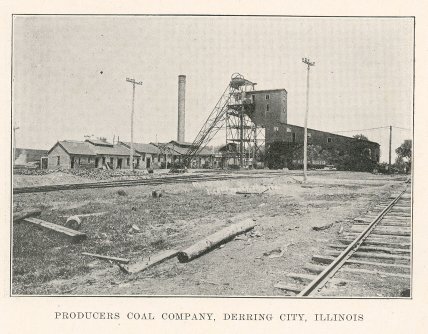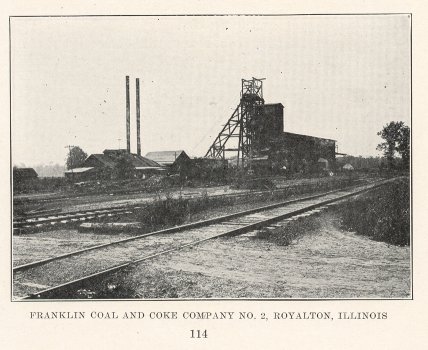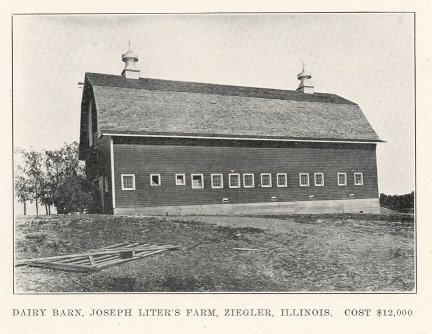
Pg 112
Odums, Ices, Jones, Roberts, Sinks, Crawfords, Rotramels and others - remained faithful to the town and pulled it through the lean years of its existence, yet in spite of this adversity it remained on the map.
In the early spring of 1894, a bunch of surveyors came to Frankfort surveying a line for a railroad from St. Elmo in Fayette Co., Ill., to Marion, county seat of Williamson County. Great excitement had now come to these people. The thought of getting a railroad seemed to encourage everyone, but soon it was learned the line would be about a mile and a half from the hill, great concern was felt, as this might ruin their town. A depot was erected and the station named West Frankfort. Then came the moving of a great many houses from the hill to the town. Most of the business from the hill was moved to the west town. Those who had been faithful to the old town now felt that the Old Frankfort was doomed sure enough.
The town of West Frankfort was inevitable and must

Pg 113
come. Plans for organizing a new school district were made and much opposition was developed in the old town. At the time of the granting of the school it was predicted that in the course of time, West Frankfort and Old Frankfort would be all in one town. Not many of the older citizens could see any comfort in the prediction.
Coal had been discovered and W. H. Hart and Walter W. Williams of Benton had undertaken to develop a mine by sinking a shaft. This started the boom. The Eldorado of Franklin County had been discovered, and the wild rush, like California of '49 soon made a busy place of West Frankfort. Hart-Williams sold their mine to Deering Coal Company in 1904, and this company continued to develop the resources of the place with much vigor. No. 18 as it was then known, was a shaft N. E. of Frankfort and almost north of Old Frankfort that was completed soon.
About this time the C. & E. I. R. R. began a system of improvements in the city by making yards and establishing a round house for engines. This railroad improvement and works were a great asset to the city.
Frankfort Heights soon became the choice location of the best residence portion of Frankfort.
While the town has two separate corporations and two names, yet it is virtually one town. West Frankfort is now only the western part of the city. Frankfort Heights is covered with fine homes. This is Franklin County's greatest city. The school census of 1918 shows Frankfort to contain about 1200 people. Southern Illinois can not boast of a more progressive town than Frankfort.
Frankfort will dedicate a handsome marker on the Heights Sept. 8, 1918.
Pg 114
The township of Denning lies west of Frankfort and south of Browning. It took its name from a prominent family who have been identified with its progress for more than one hundred years.
The Dennings, Hubbards and Dements seem to have been the first whites to enter the township. The Dennings took an active part in the organization of the county, settling near Plumfield, S. M. Hubbard, the most noted of that family, was the first county and circuit clerk in the county. The Dements, related to the Dennings, were soldiers in the Black Hawk War. A descendant of the Dements was three times Secretary of State of Illinois.
Plumfield is one of the old towns of the county. Here

Pg 115
was built the first toll bridge in the county. Townmount Prairie in Denning Township, is one of the fertile prairies of the county.
The prominent families of Denning are the Murphys, Dilliards, Deasons, Dawsens, Dorris, Jones, Averys, Duncans, Barbreys, Clarks, Crims, Dotys, Ezells, Biggs, Karns, Sanders, Hughes, Childers, Morgans, Ralls, Lemasters, Mitchells, Swoffords, Haine, Stewarts, Joiners, Young and others. The towns of the township are: West Frankfort, Orient, Freeman, Plumfield and Cambon. A new town is just starting on the Townmount Prairie and is known as Pershing and everything points to a lively place in the next few years. Orient is a mining town and seems to be growing rapidly. There are now more than 1500 people in this place. Freeman is on the line between Williamson and Franklin Counties. This is a lively mining town. Plumfield on the Big Muddy and on the old Kaskaskia trail, has been a trading point for that locality for

Pg 116
many years. The mines have been near enough that a great many live in Plumfield and work at the mines.
The schools of Denning are: Townmount, Orient, Plum-geld, Rogers, Freeman, Joiner and Crim. The churches are:
Baptist-Townmount; Methodist-Bethel; Christian-White. Politically the township is Democratic.
This township is in the southwest corner of Franklin County and contains the largest prairie in the county from which it took its name. The early settlers were C. H. Humphreys, Gilbert Browning and C. W. Campbell. These families have remained in the township for more than a hundred years. Later came the Snyders, Blakes, Popes, Martins, Prices, Hubbards, Pierces, Royalls, Kirkpatricks, Dials, Mitchells, Mannerings, Dawsons, Cars, Winchesters and others who have played an active part in making Six Mile Township what it is to-day.

Pg 117
The coming of the coal mines have caused towns to spring up. Royalton in the southwest part of the township is a thriving mining town of about 3,000 people. There are two active coal mines located near the town.
Zeigler, the first coal mine in the county was built by Joseph Leiter and later leased by Bell & Zoller. There are about 2,500 people in Zeigler, which was owned by Mr. Leiter, but recently, lots have been sold and now a great many own their property. Zeigler has an up-to-date school.
Bush and Clebern are also thriving towns in the township.
The Iron Mountain R. R. runs diagonally through the township. The Illinois Central also passes through. The schools of Six Mile Township are Four Mile, Pierce, North, South, Royalton, Zeigler and Center. The churches are: Christian-North and Royalton and Center; Baptist-Zeigler.
Politically Six Mile is Democratic and Daniel McPhail is the present supervisor.
Pg 118
Hill and Nye, railroad promoters came into Southern Illinois in 1875 and projected and surveyed a route for a railroad called the Belleville and Eldorado Railroad, extending from Belleville in St. Clair County to Eldorado in Saline County.
These promoters had no money but abundant supply of "nerve and wind" and by using these resources judiciously, the road was finally built.
They began building from Eldorado in 1877. They expected the counties through which they passed to take stock in the road and also to issue bonds to have the road built. The road was built from Eldorado to the Franklin County line. There it must stop until proper arrangements could be made with Franklin County. This end of the road was called "West End" now a lively station on the Illinois Central Railroad.
The eastern part of Franklin County did a great deal of wheat marketing at this railroad town. The first locomotive entered Franklin County at West End.
After some time Franklin County was ready to take stock and issue bonds. Henry Hudson of Benton sold $75,000 of these bonds for Hill and Nye, so that the iron rails could be secured to build the road from West End to Benton, which was done and the whistle of the first locomotive to enter Benton was heard on Sept. 23, 1879. This locomotive was called "General Gibson" and was the old type of engine. The first conductor on this early road was Barney Blaney. He continued to make his runs regularly until a few years ago.
The trains on this road were very irregular and did not live up to the schedule time. The figures on the time table
Pg 119
indicating the time of arrival were always preceded by the word "About."
Frank Trott was the first station agent at Benton and was asked the oft familiar question, "When will the train come ?" Glancing down the track he would say, "Pretty soon, now, here comes Barney's dog."
The Belleville and Eldorado road was completed to Du Quoin, May 1, 1880. It was sold to the St. Louis, Alton and Terre Haute Railroad Company, July 1, 1880, and was called the "Cairo Shortline" until 1895, when it was sold to the Illinois Central Railroad Company. Since then the road has been greatly improved.
Johnson Brothers of St. Elmo, Illinois, railroad contractors, conceived the idea of building a road from St. Elmo in Fayette County to Marion in Williamson, a distance of 100 miles. This road was surveyed in the spring of 1894 and work soon began and was completed that summer and fall. This was before the days of the coal development in Franklin County. The road was known as the Chicago, Paducah and Memphis Railroad Co. It was sold to the Chicago and Eastern Illinois Railroad Company in 1897; since then the road has been operated by this company. The coal development in subsequent years has made the road a profitable investment.
The St. Louis, Iron Mountain and Southern was completed to Benton, July, 1908. It belongs to the Missouri Pacific System of railroads. The coal development has caused many lines of railroads to become interested in hauling the coal to market.
The J. J. Hill System of Railroads, the Great Northern, and the Chicago, Quincy and Burlington roads desired to reach the coal fields of this county. They purchased the Old Jacksonville and South Eastern Railroad. Then building from Centralia to Herrin by way of Sesser, Rend City, Valier, Christopher, Zeigler, West Frankfort, and Freeman. This road hauls more coal from the county than any other road.
Pg 120
The Illinois Central has built a spur road to West Frankfort and to Herrin.
Franklin County now has three railroads leading to Chicago and two to St. Louis.
Pg 121
William D. Seeber, dean of the present county officials, was born in Cortland County, New York, May 20, 1843. He graduated from a commercial college at Binghampton, New York, in 1864. Came to Franklin County, Illinois, the following year and began teaching school, continuing in this profession for four years.
He was married to Florence I. Pope in Popes Prairie in Franklin County, Sept. 16, 1869, was elected assessor in Six Mile Township two terms and justice of the peace one term of four years. In 1878 he was elected sheriff of Franklin County, serving one term. In 1881 Mr. Seeber moved to Wayne County, Illinois, living there till the fall of 1884 and during the time in Wayne County was elected justice of the peace. He returned to Franklin County and was elected police magistrate in April, 1899, serving four years. Mr. Seeber was selected deputy county clerk and served from June 1, 1898 to Nov. I, 1902. He was elected county clerk Nov. 4, 1902 and re-elected 1906, 1910 and 1914. Mr. Seeber has had twenty years of service in the county clerk's office serving longer than any clerk the county has had since the office has been separated from the circuit clerk's office.
Q. E. Burgess, County Treasurer and Collector, ex-officio Supervisor of Assessments, Franklin County, Illinois, was born in Franklin County, Illinois, Nov. 19, 1866, son of R. E. and Sarah Burgess. He was reared on a farm, educated in the